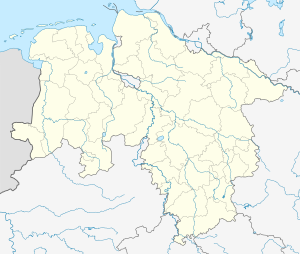Echo bridge
Coordinates: 52 ° 14 ′ 37 ″ N , 10 ° 31 ′ 21 ″ E
| Echo bridge | ||
|---|---|---|
| The Echo Bridge and other railway bridges from the south (2014). | ||
| Official name | Oker Bridge South | |
| use | Railway bridge for three tracks (dissolved) | |
| Crossing of | Oker | |
| place | Braunschweig | |
| construction | Three-hinged arch made of reinforced concrete | |
| overall length | 109.82 m | |
| width | 14.30 m | |
| Clear width | 41 m | |
| height | 15.54 m | |
| start of building | 1943 | |
| completion | 5th October 1956 | |
| opening | 1960 | |
| Status | Rails dismantled | |
| closure | around 2000 | |
| location | ||
|
|
||
The imposing arch of the southern railway bridge in the Braunschweig kennel area is known as the echo bridge . It owes its name to a clear and clearly delayed echo that is reflected back to the person calling through the smooth concrete arches and the water surface below. The bridge was inaugurated with the construction of the Braunschweig marshalling yard in 1960. Since the closure of this station in the 21st century, the tracks have been dismantled and a new use as a bicycle crossing is sought.
history
The bridge was built for the new construction of the Braunschweig marshalling yard . As early as 1928, a railway line and another bridge at Eisenbüttel were built parallel to the Magdeburg line for what was then the Ostbahnhof . In 1938 it was decided to build the new Braunschweig main station and the entire restructuring of the railway system surrounding the city. The necessary construction work began during the war and was completed in 1960.
The completely new marshalling yard required a three-track entry area, which ran south of the existing railway line with little distance and at a significantly higher level. An over 18 meter high embankment was piled up mainly from debris from the Braunschweig city center and the bridge, visible from afar, with a span of 41 meters over the Oker was built. Construction work began in 1943 on the abutment with foundations over eight meters deep. Due to the war, this work lasted until 1945. After construction work resumed, the three-hinged arches were released on October 5, 1956. The Oker, which until the 1950s curved in an arch below Neu-Richmond, was straightened towards the new bridge and a bridge that had existed until then, which connected the Kennelweg to Wolfenbüttler Strasse, was demolished.
Another bridge in the course of the marshalling yard was built over Wolfenbütteler Strasse.
Current condition
The bridge is no longer used for rail traffic because the entire former entrance area for the marshalling yard has been closed. All tracks have already been removed. The bridges over the A 391 on the former route to the west have been dismantled. In place of a demolished bridge, a new one was built over the motorway for the Ringgleis cycle path , which has been running on the embankment as far as the Echo Bridge since February 2018. An eastern continuation of the ring track across the Echo Bridge is planned.
Individual evidence
- ↑ The bridge that can speak. In: Wolfenbütteler Zeitung. dated August 8, 2012.
- ↑ Bundesbahndirektion Hannover (Ed.): Central Station Braunschweig 1960. Published jointly for the opening of the new Braunschweig Hauptbahnhof on October 1, 1960 by the Federal Railway Directorate Hanover, the City of Braunschweig and the Braunschweig Chamber of Commerce and Industry. Braunschweig 1960, p. 83 ff.
- ↑ The old railway bridge at the Kennel is to become a footpath and bike path. In: Braunschweiger Zeitung. dated December 8, 2008.


